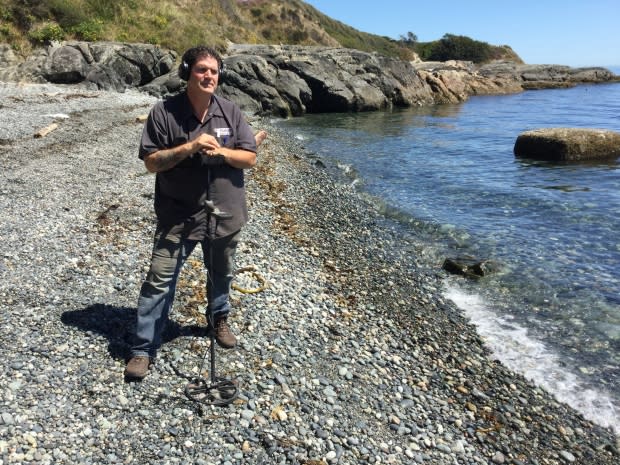Metal detector enthusiast unearths thousands of historic items on Vancouver Island
Tim Barkasy got his metal detector as a birthday gift from his children a decade ago and, within his first hour of using the machine, was shocked to find two Canadian coins from the mid-1800s.
"It was enough to be hooked and wanting to find the next thing," he said of his inaugural outing around Willows Beach in Greater Victoria. "It's like a shot of dopamine."
Ten years later, Barkasy says the southern parts of Vancouver Island are a jackpot for hidden history.
Barkasy is a plumber by trade, but most evenings he likes to let his thoughts drift as his machine "bleeps" and "blips" through a pair of headphones.

He says he's discovered thousands of items — many of them historic and valuable — by scouring south island parks and beaches.
Coins from all over the world
"I couldn't believe it when I found a gold coin from 1901," said Barkasy, holding up a barely-scratched American coin embellished with the face of Lady Liberty. "Ninety-nine per cent of people who do this hobby will never find one."
Barkasy has found coins from all over the world — Fiji, Britain, Mexico, to name a few. He once found an American coin from 1841 on a high school field.

"[I've found] medallions, tokens, skeleton keys, old make-up containers and old bullets," he said.
Barkasy is part of a local metal detecting club, which has about 400 members, according to its Facebook page.
Barkasy said he and a "half dozen other guys" consider themselves some of the more extreme fans, adding he now spends at least 360 days a year hunting.
Historian not surprised
John Adams, a local historian says he's not surprised the ground in the old port city may hold more history than other parts of B.C.
Apart from Indigenous peoples who traded goods on the island, British colonizers began settling the island in the mid-1800s and could have "dropped or discarded" their items, Adams said.
Fort Victoria, founded by the Hudson's Bay Company in 1843, also enticed fur traders to bring their goods to the island. A few years later, the Royal Navy established itself in Esquimalt, where British marines travelled from countries where they'd been stationed previously. Many of them certainly carried international currency, Adams said.

Grant Keddie, an archaeologist at the Royal B.C. Museum, said a current project along the Esquimalt harbour is underway to retrieve a wealth of ocean artifacts.
"There are a lot of things associated with naval history … like bronze plaques from boats, keys to their radiation rooms. Each thing has a story in itself," said Keddie. "There's probably an absolute wealth of information at the bottom of all of the inlets surrounding Greater Victoria."
Historic garbage dumps
Keddie noted that in the 19th century, many residents would have thrown their trash over the bank and into the ocean, where a "garbage dump has built over time."
"Those are the ones we'd like to preserve, especially if there are things from the 1850s or '60s," he said.
Keddie encourages south island metal detector enthusiasts to bring in their artifacts to be examined and catalogued.
Barkasy said there are a number of items he's sent to museums, including a 1947 Canadian Briar championship ring, which he shipped to a museum in Ottawa.
"If it's something specific to somebody, then I have no problem sending it back to them."


